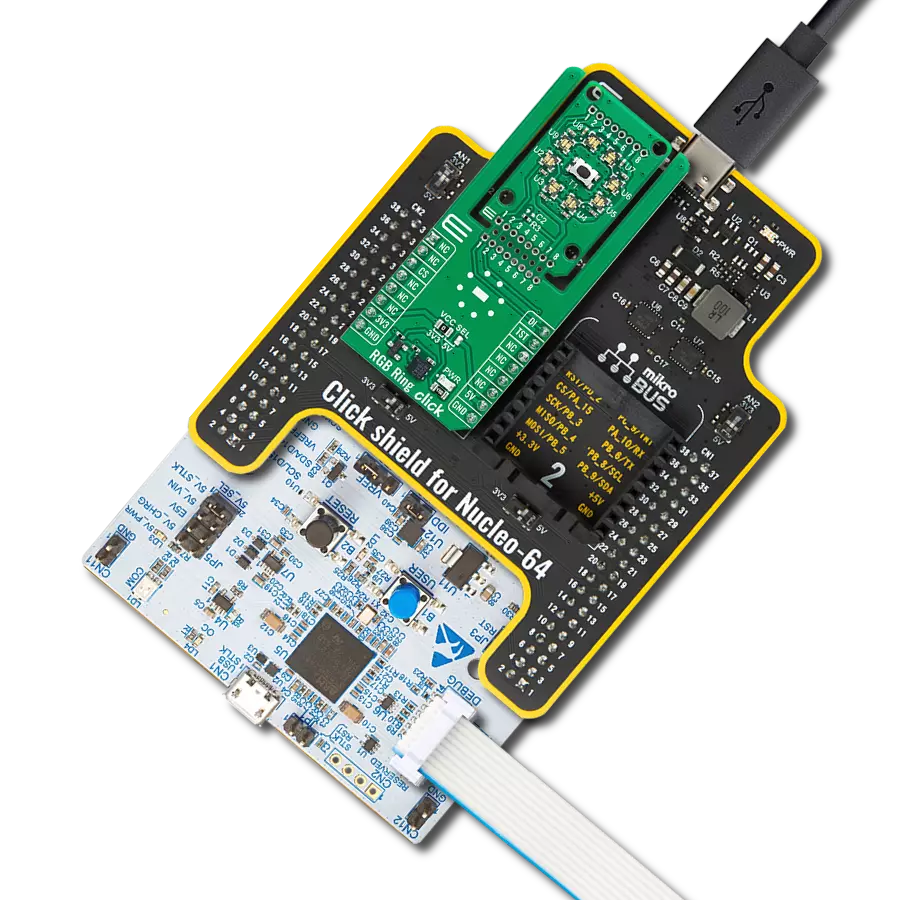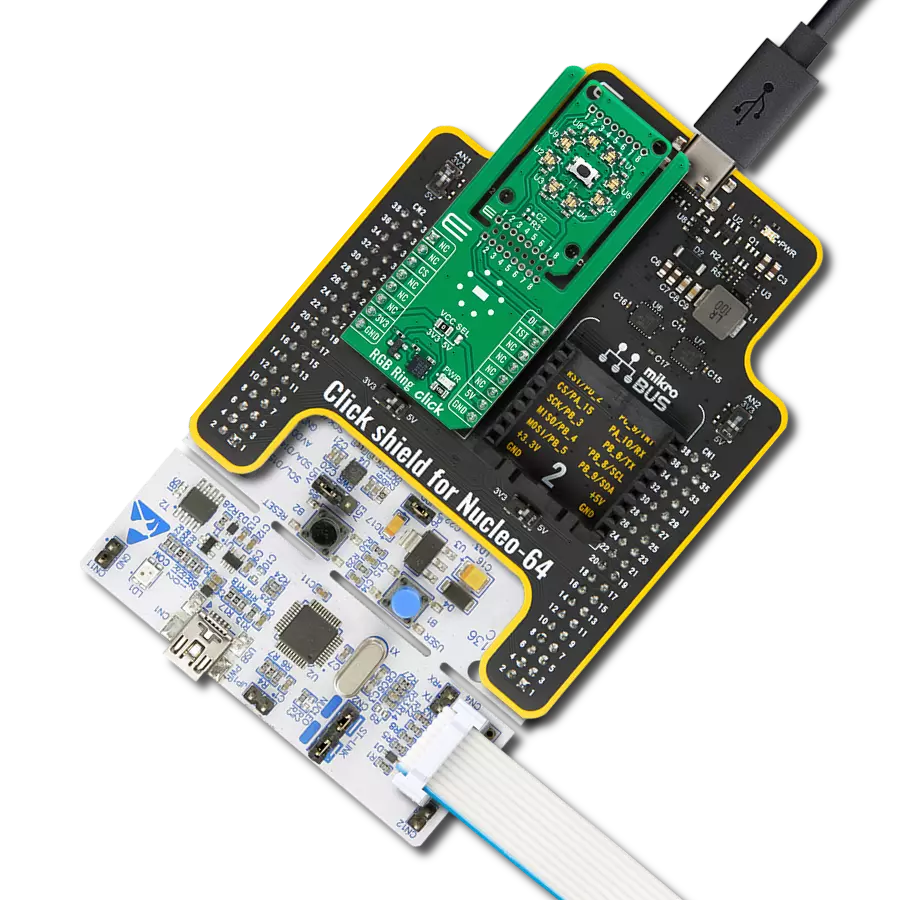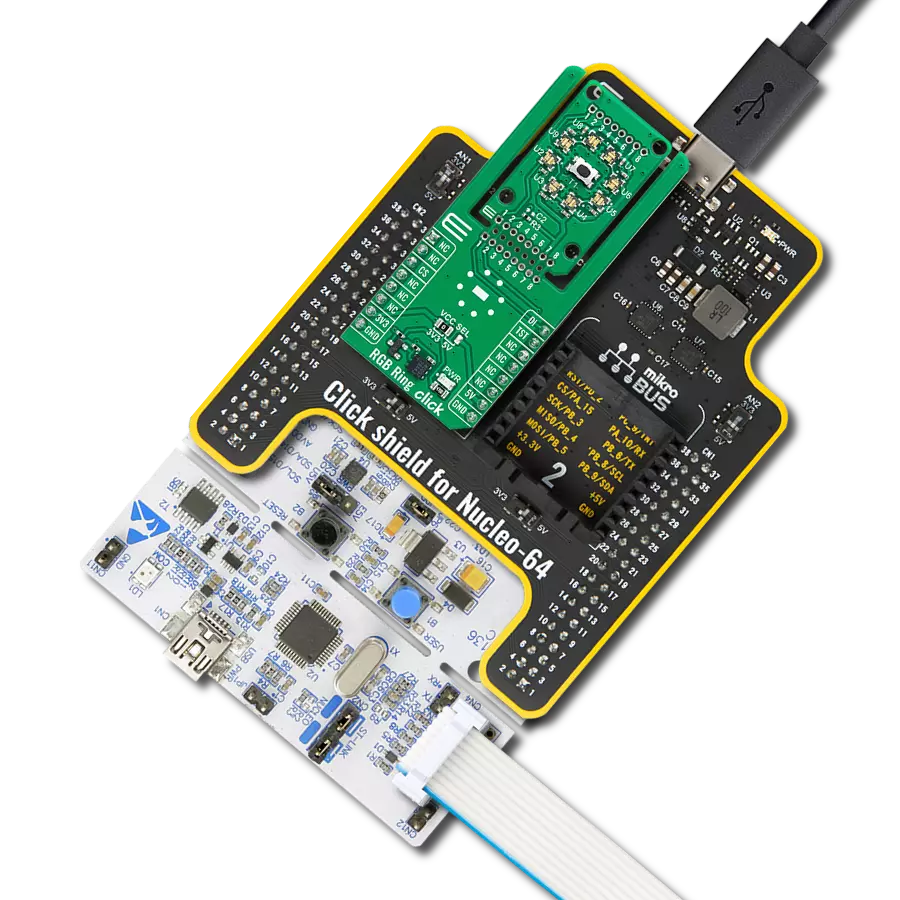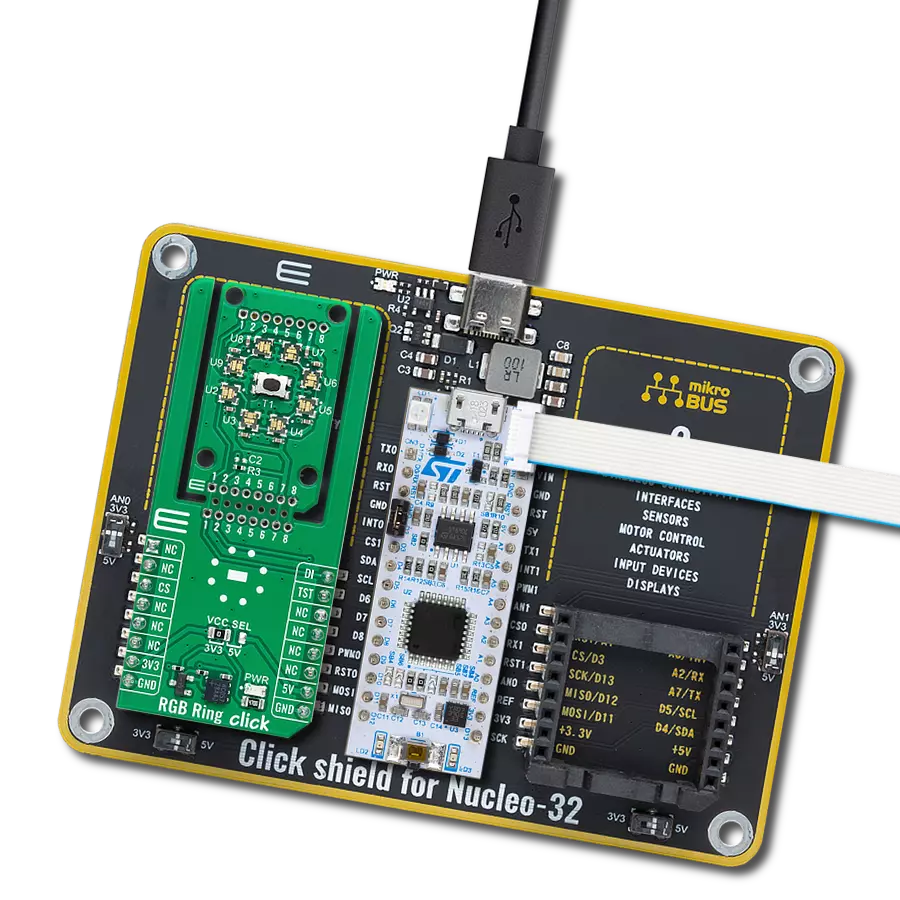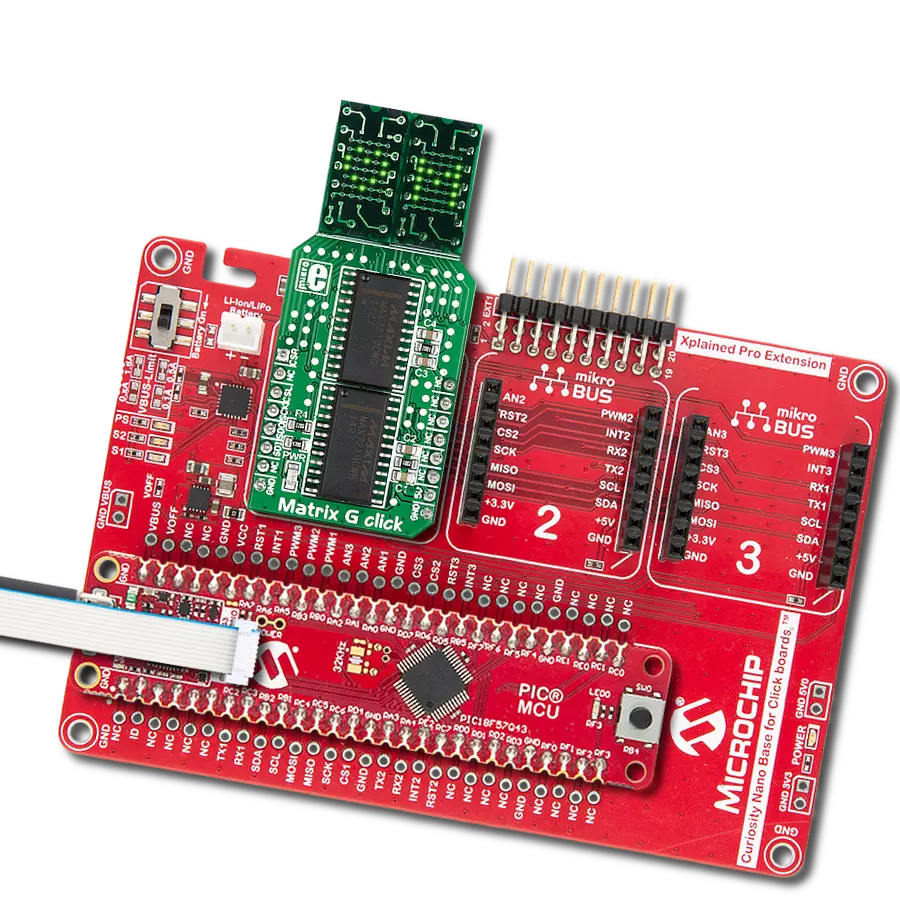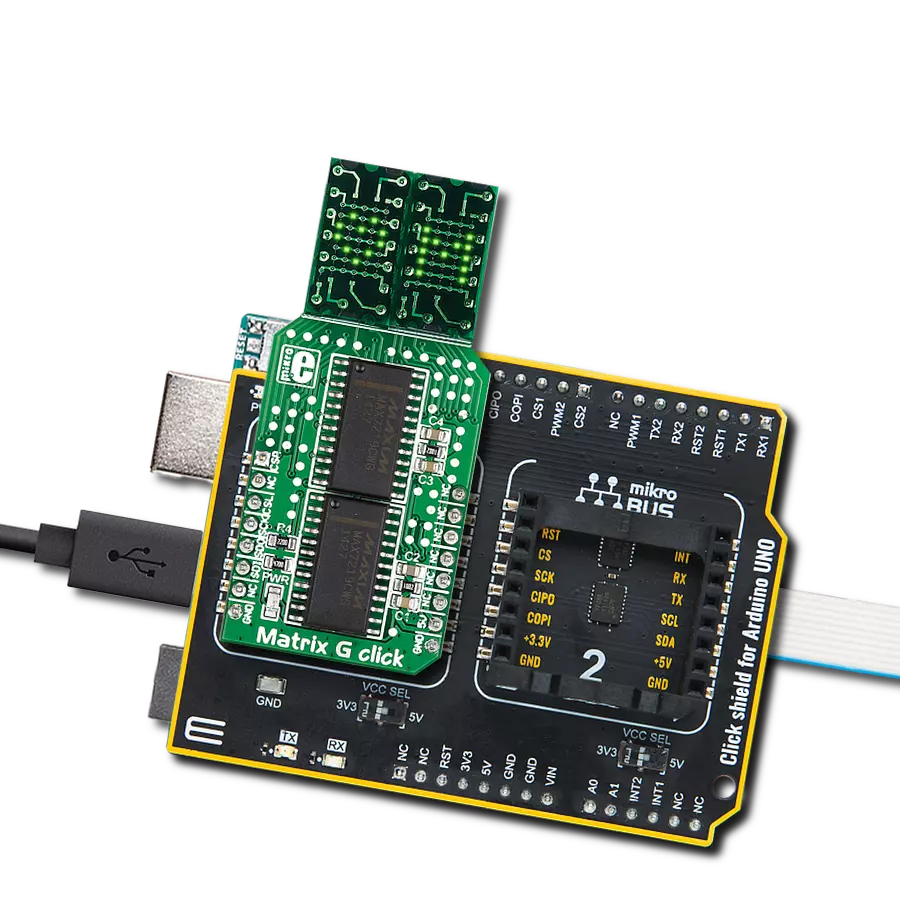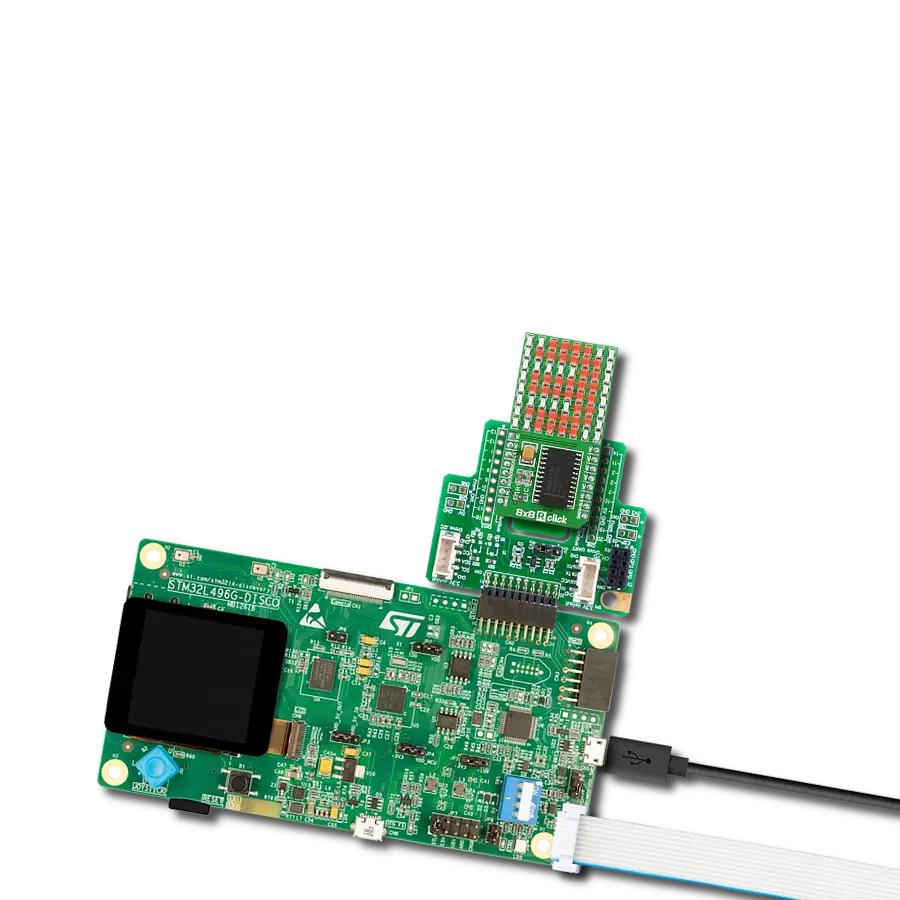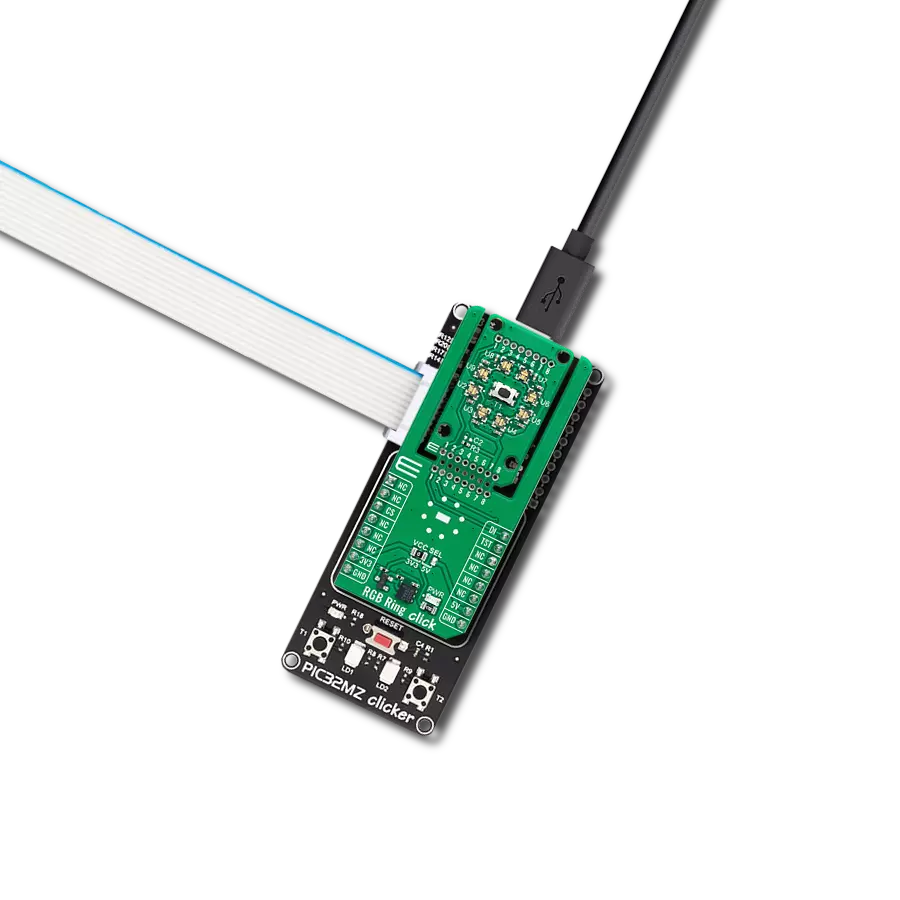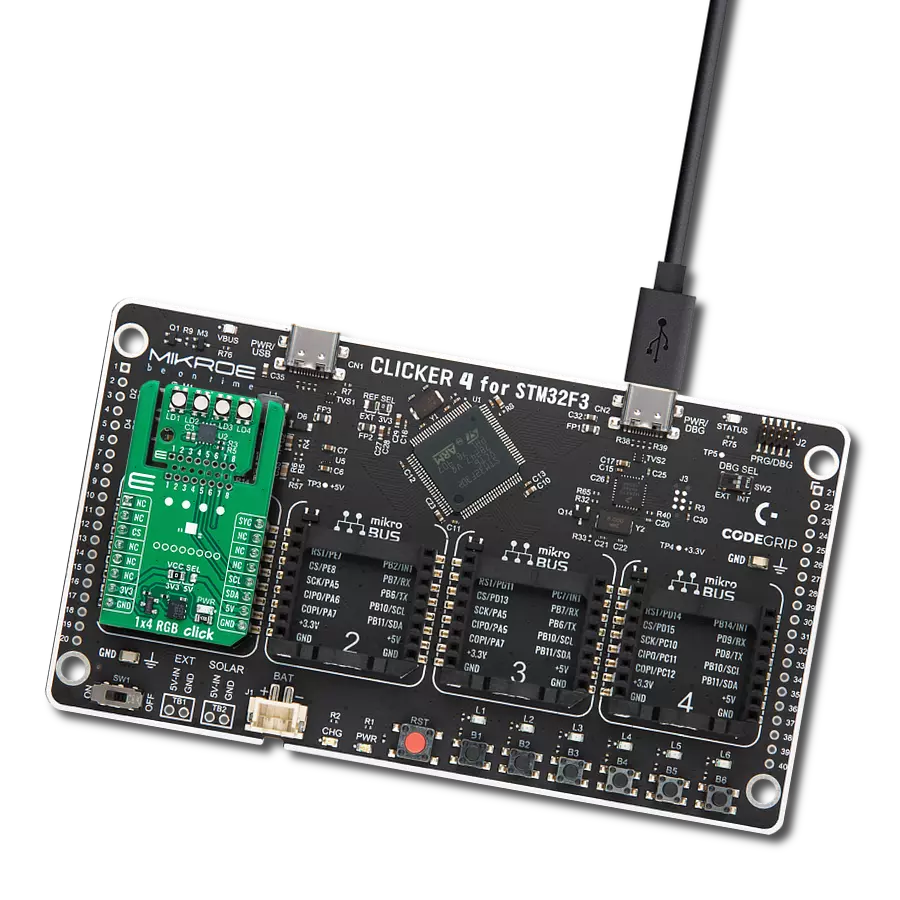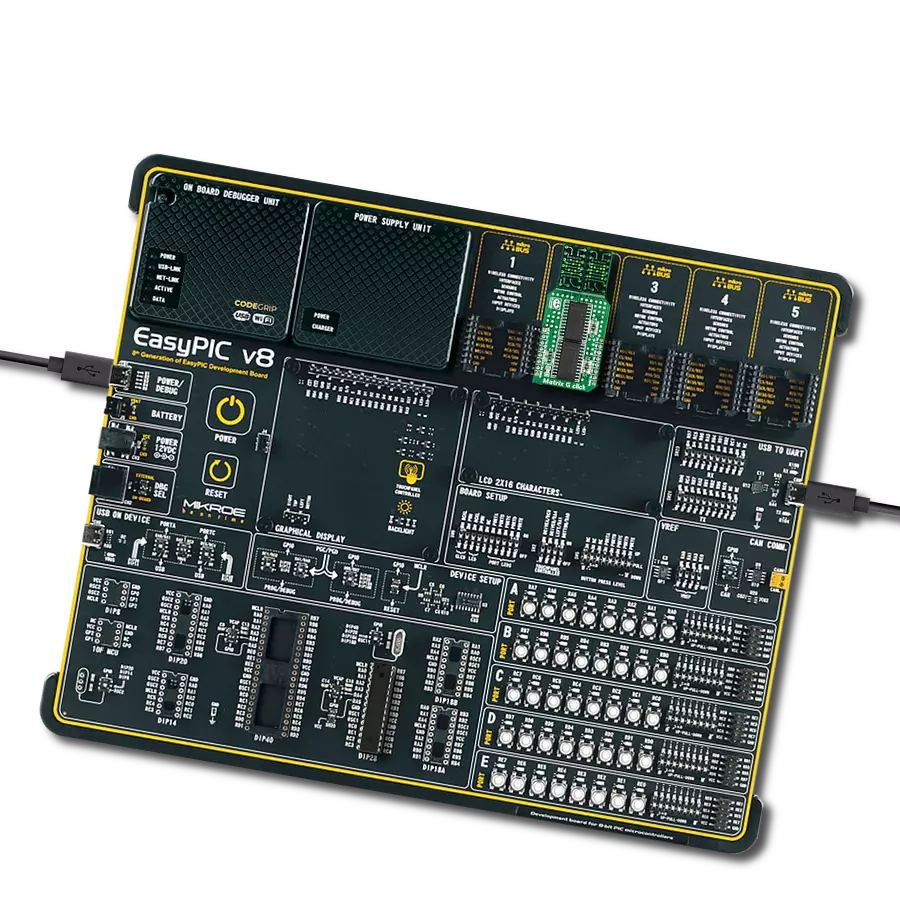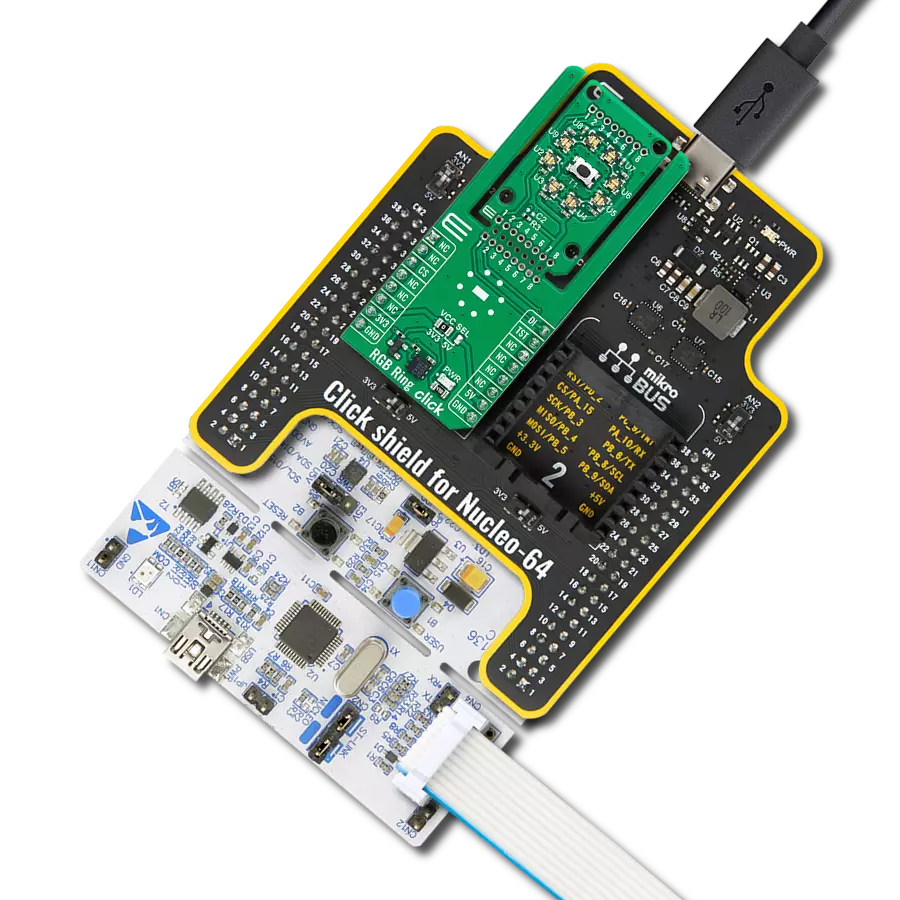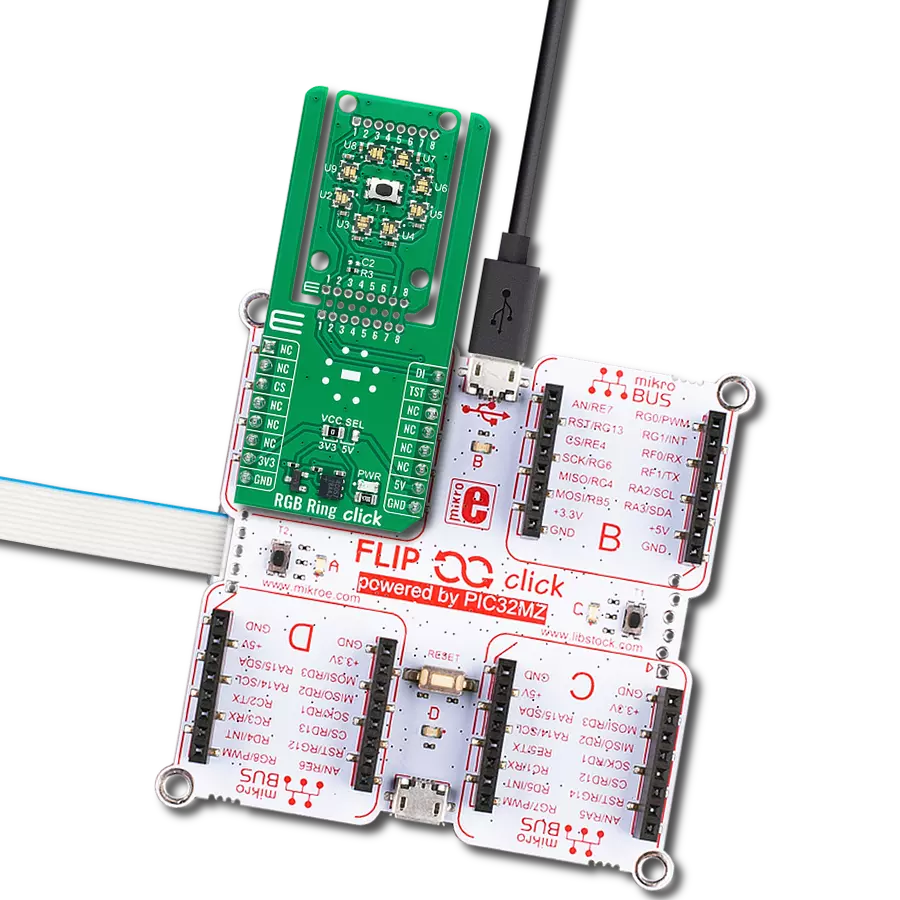Create status indicators, visual cues, and feedback through color-coded lighting in various applications
A
A
Hardware Overview
How does it work?
1x4 RGB Click is based on the LP5812, an advanced RGB LED driver from Texas Instruments. This component manages four onboard RGB LEDs (CLV1A-FKB-CJ1M1F1BB7R4S3) with an autonomous animation engine. The LP5812 features an ultra-low operation current of about 0.4mA in Active mode at a maximum LED current setting of 25.5mA. When all LEDs are off, the device enters Standby mode to minimize power consumption while retaining data. Its autonomous animation engine allows for vivid and dynamic lighting effects without needing brightness control commands from the controller, making it ideal for applications in portable and wearable electronics, gaming, home entertainment, IoT, networking, and industrial HMI. 1x4 RGB Click is designed in a unique format supporting the newly introduced
MIKROE feature called "Click Snap." Unlike the standardized version of Click boards, this feature allows the main IC area to become movable by breaking the PCB, opening up many new possibilities for implementation. Thanks to the Snap feature, the LP5812 can operate autonomously by accessing its signals directly on the pins marked 1-8. Additionally, the Snap part includes a specified and fixed screw hole position, enabling users to secure the Snap board in their desired location. This Click board™ uses a standard 2-wire I2C interface to communicate with the host MCU, supporting Fast mode Plus with up to 1MHz of frequency clock. It also supports both analog and PWM dimming. Analog dimming offers 256 steps for adjusting the output current of each LED, while PWM dimming, enabled by an 8-bit configurable
PWM generator, ensures smooth brightness control. The SYC pin can serve as a PWM clock input or output, allowing multiple 1x4 RGB Click boards to synchronize their animations using a single clock signal from one of the LP5812 devices or an external controller. For enhanced visual performance, optional exponential PWM dimming can be activated for individual LEDs, providing a more human-eye-friendly experience. This Click board™ can operate with either 3.3V or 5V logic voltage levels selected via the VCC SEL jumper. This way, both 3.3V and 5V capable MCUs can use the communication lines properly. Also, this Click board™ comes equipped with a library containing easy-to-use functions and an example code that can be used as a reference for further development.
Features overview
Development board
Arduino UNO is a versatile microcontroller board built around the ATmega328P chip. It offers extensive connectivity options for various projects, featuring 14 digital input/output pins, six of which are PWM-capable, along with six analog inputs. Its core components include a 16MHz ceramic resonator, a USB connection, a power jack, an
ICSP header, and a reset button, providing everything necessary to power and program the board. The Uno is ready to go, whether connected to a computer via USB or powered by an AC-to-DC adapter or battery. As the first USB Arduino board, it serves as the benchmark for the Arduino platform, with "Uno" symbolizing its status as the
first in a series. This name choice, meaning "one" in Italian, commemorates the launch of Arduino Software (IDE) 1.0. Initially introduced alongside version 1.0 of the Arduino Software (IDE), the Uno has since become the foundational model for subsequent Arduino releases, embodying the platform's evolution.
Microcontroller Overview
MCU Card / MCU

Architecture
AVR
MCU Memory (KB)
32
Silicon Vendor
Microchip
Pin count
28
RAM (Bytes)
2048
You complete me!
Accessories
Click Shield for Arduino UNO has two proprietary mikroBUS™ sockets, allowing all the Click board™ devices to be interfaced with the Arduino UNO board without effort. The Arduino Uno, a microcontroller board based on the ATmega328P, provides an affordable and flexible way for users to try out new concepts and build prototypes with the ATmega328P microcontroller from various combinations of performance, power consumption, and features. The Arduino Uno has 14 digital input/output pins (of which six can be used as PWM outputs), six analog inputs, a 16 MHz ceramic resonator (CSTCE16M0V53-R0), a USB connection, a power jack, an ICSP header, and reset button. Most of the ATmega328P microcontroller pins are brought to the IO pins on the left and right edge of the board, which are then connected to two existing mikroBUS™ sockets. This Click Shield also has several switches that perform functions such as selecting the logic levels of analog signals on mikroBUS™ sockets and selecting logic voltage levels of the mikroBUS™ sockets themselves. Besides, the user is offered the possibility of using any Click board™ with the help of existing bidirectional level-shifting voltage translators, regardless of whether the Click board™ operates at a 3.3V or 5V logic voltage level. Once you connect the Arduino UNO board with our Click Shield for Arduino UNO, you can access hundreds of Click boards™, working with 3.3V or 5V logic voltage levels.
Used MCU Pins
mikroBUS™ mapper
Take a closer look
Click board™ Schematic

Step by step
Project assembly
Track your results in real time
Application Output
1. Application Output - In Debug mode, the 'Application Output' window enables real-time data monitoring, offering direct insight into execution results. Ensure proper data display by configuring the environment correctly using the provided tutorial.

2. UART Terminal - Use the UART Terminal to monitor data transmission via a USB to UART converter, allowing direct communication between the Click board™ and your development system. Configure the baud rate and other serial settings according to your project's requirements to ensure proper functionality. For step-by-step setup instructions, refer to the provided tutorial.

3. Plot Output - The Plot feature offers a powerful way to visualize real-time sensor data, enabling trend analysis, debugging, and comparison of multiple data points. To set it up correctly, follow the provided tutorial, which includes a step-by-step example of using the Plot feature to display Click board™ readings. To use the Plot feature in your code, use the function: plot(*insert_graph_name*, variable_name);. This is a general format, and it is up to the user to replace 'insert_graph_name' with the actual graph name and 'variable_name' with the parameter to be displayed.

Software Support
Library Description
This library contains API for 1x4 RGB Click driver.
Key functions:
c1x4rgb_set_rgb_color- This function sets the desired values of RGB colors for the selected LED by using the I2C serial interface.c1x4rgb_enable_leds- This function turns on the desired LEDs by using the I2C serial interface.c1x4rgb_set_tmc_mode- This function configures the desired LED drive mode as TCM 1/2/3/4 scans using the I2C serial interface.
Open Source
Code example
The complete application code and a ready-to-use project are available through the NECTO Studio Package Manager for direct installation in the NECTO Studio. The application code can also be found on the MIKROE GitHub account.
/*!
* @file main.c
* @brief 1x4 RGB Click example
*
* # Description
* This example demonstrates the use of the 1x4 RGB Click board
* by controlling the color of the LEDs [LD1-LD4].
*
* The demo application is composed of two sections :
*
* ## Application Init
* Initialization of I2C module and log UART.
* After driver initialization, the app executes a default configuration.
*
* ## Application Task
* The demo example shows the color change of four RGB LEDs,
* starting with red color, through green and blue, and ending with white.
* These LEDs actually consist of three single-colored LEDs
* (Red-Green-Blue) in a single package.
* Various colors can be reproduced by mixing the intensity of each LED.
*
* @author Nenad Filipovic
*
*/
#include "board.h"
#include "log.h"
#include "c1x4rgb.h"
static c1x4rgb_t c1x4rgb;
static log_t logger;
// Demo RGB color intensity
#define DEMO_COLOR_INT_0 0
#define DEMO_COLOR_INT_100 100
void application_init ( void )
{
log_cfg_t log_cfg; /**< Logger config object. */
c1x4rgb_cfg_t c1x4rgb_cfg; /**< Click config object. */
/**
* Logger initialization.
* Default baud rate: 115200
* Default log level: LOG_LEVEL_DEBUG
* @note If USB_UART_RX and USB_UART_TX
* are defined as HAL_PIN_NC, you will
* need to define them manually for log to work.
* See @b LOG_MAP_USB_UART macro definition for detailed explanation.
*/
LOG_MAP_USB_UART( log_cfg );
log_init( &logger, &log_cfg );
log_info( &logger, " Application Init " );
// Click initialization.
c1x4rgb_cfg_setup( &c1x4rgb_cfg );
C1X4RGB_MAP_MIKROBUS( c1x4rgb_cfg, MIKROBUS_1 );
if ( I2C_MASTER_ERROR == c1x4rgb_init( &c1x4rgb, &c1x4rgb_cfg ) )
{
log_error( &logger, " Communication init." );
for ( ; ; );
}
if ( C1X4RGB_ERROR == c1x4rgb_default_cfg ( &c1x4rgb ) )
{
log_error( &logger, " Default configuration." );
for ( ; ; );
}
log_info( &logger, " Application Task " );
Delay_ms ( 1000 );
}
void application_task ( void )
{
log_printf( &logger, "\r\n\n RED: " );
for ( uint8_t led_pos = C1X4RGB_LED_POS_LD1; led_pos <= C1X4RGB_LED_POS_LD4; led_pos++ )
{
if ( C1X4RGB_OK == c1x4rgb_set_rgb_color( &c1x4rgb, led_pos, DEMO_COLOR_INT_100,
DEMO_COLOR_INT_0,
DEMO_COLOR_INT_0 ) )
{
log_printf( &logger, " LD%d ", ( uint16_t ) led_pos );
Delay_ms ( 100 );
}
}
log_printf( &logger, "\r\n GREEN: " );
for ( uint8_t led_pos = C1X4RGB_LED_POS_LD1; led_pos <= C1X4RGB_LED_POS_LD4; led_pos++ )
{
if ( C1X4RGB_OK == c1x4rgb_set_rgb_color( &c1x4rgb, led_pos, DEMO_COLOR_INT_0,
DEMO_COLOR_INT_100,
DEMO_COLOR_INT_0 ) )
{
log_printf( &logger, " LD%d ", ( uint16_t ) led_pos );
Delay_ms ( 100 );
}
}
log_printf( &logger, "\r\n BLUE: " );
for ( uint8_t led_pos = C1X4RGB_LED_POS_LD1; led_pos <= C1X4RGB_LED_POS_LD4; led_pos++ )
{
if ( C1X4RGB_OK == c1x4rgb_set_rgb_color( &c1x4rgb, led_pos, DEMO_COLOR_INT_0,
DEMO_COLOR_INT_0,
DEMO_COLOR_INT_100 ) )
{
log_printf( &logger, " LD%d ", ( uint16_t ) led_pos );
Delay_ms ( 100 );
}
}
log_printf( &logger, "\r\n WHITE:" );
for ( uint8_t led_pos = C1X4RGB_LED_POS_LD1; led_pos <= C1X4RGB_LED_POS_LD4; led_pos++ )
{
if ( C1X4RGB_OK == c1x4rgb_set_rgb_color( &c1x4rgb, led_pos, DEMO_COLOR_INT_100,
DEMO_COLOR_INT_100,
DEMO_COLOR_INT_100 ) )
{
log_printf( &logger, " LD%d ", ( uint16_t ) led_pos );
Delay_ms ( 100 );
}
}
}
int main ( void )
{
/* Do not remove this line or clock might not be set correctly. */
#ifdef PREINIT_SUPPORTED
preinit();
#endif
application_init( );
for ( ; ; )
{
application_task( );
}
return 0;
}
// ------------------------------------------------------------------------ END
Additional Support
Resources
Category:LED Matrix



















